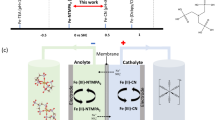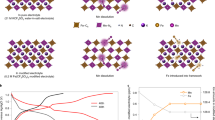Abstract
In the search for new positive-electrode materials for lithium-ion batteries, recent research has focused on nanostructured lithium transition-metal phosphates that exhibit desirable properties such as high energy storage capacity combined with electrochemical stability1,2. Only one member of this class—the olivine LiFePO4 (ref. 3)—has risen to prominence so far, owing to its other characteristics, which include low cost, low environmental impact and safety. These are critical for large-capacity systems such as plug-in hybrid electric vehicles. Nonetheless, olivine has some inherent shortcomings, including one-dimensional lithium-ion transport and a two-phase redox reaction that together limit the mobility of the phase boundary4,5,6,7. Thus, nanocrystallites are key to enable fast rate behaviour8,9. It has also been suggested that the long-term economic viability of large-scale Li-ion energy storage systems could be ultimately limited by global lithium reserves, although this remains speculative at present. (Current proven world reserves should be sufficient for the hybrid electric vehicle market, although plug-in hybrid electric vehicle and electric vehicle expansion would put considerable strain on resources and hence cost effectiveness.) Here, we report on a sodium/lithium iron phosphate, A2FePO4F (A=Na, Li), that could serve as a cathode in either Li-ion or Na-ion cells. Furthermore, it possesses facile two-dimensional pathways for Li+ transport, and the structural changes on reduction–oxidation are minimal. This results in a volume change of only 3.7% that—unlike the olivine—contributes to the absence of distinct two-phase behaviour during redox, and a reversible capacity that is 85% of theoretical.
This is a preview of subscription content, access via your institution
Access options
Subscribe to this journal
Receive 12 print issues and online access
$259.00 per year
only $21.58 per issue
Buy this article
- Purchase on Springer Link
- Instant access to full article PDF
Prices may be subject to local taxes which are calculated during checkout




Similar content being viewed by others
References
Bruce, P., Scrosati, B., Tarascon, J.-M. & van Schalkwijk, W. Nanostructured materials for advanced energy conversion and storage devices. Nature Mater. 4, 366–377 (2005).
Herle, P. S., Ellis, B. & Nazar, L. F. Nanonetwork conduction in olivine phosphates. Nature Mater. 3, 147–152 (2004).
Padhi, A. K., Nanjundaswamy, K. S. & Goodenough, J. B. Phospho-olivines as positive electrode materials for rechargeable lithium batteries. J. Electrochem. Soc. 144, 1188–1194 (1997).
Maxisch, T., Zhou, F. & Ceder, G. Ab initio study of the migration of small polarons in olivine LixFePO4 and their association with lithium ions and vacancies. Phys. Rev. B 73, 104301 (2006).
Delacourt, C., Poizot, P., Tarascon, J. M. & Masquelier, C. The existence of a temperature-driven solid solution in LixFePO4 . Nature Mater. 4, 254–260 (2005).
Yamada, A. et al. Room temperature miscibility gap in LixFePO4 . Nature Mater. 5, 357–360 (2006).
Ellis, B., Perry, L. K., Ryan, D. H. & Nazar, L. F. Small polaron hopping in LixFePO4 solid solutions: Coupled lithium-ion and electron mobility. J. Am. Chem. Soc. 128, 11416–11422 (2006).
Delacourt, C., Poizot, P., Levasseur, S. & Masquelier, C. Size effects on carbon-free LiFePO4 powders: The key to superior energy density. Electrochem. Solid-State Lett. 9, A352–A355 (2006).
Meethong, N., Huang, H.-Y., Carter, W. C. & Chiang, Y.-M. Size-dependent lithium miscibility gap in nanoscale Li1−xFePO4 . Electrochem. Solid-State Lett. 10, A134–A138 (2007).
Yin, S. C., Edwards, R., Taylor, N., Herle, P. S. & Nazar, L. F. Dimensional reduction: Synthesis and structure of layered Li5M(PO4)2F2 (M=V, Cr). Chem. Mater. 18, 1745–1752 (2006).
Dutreilh, M., Chevalier, C., El-Ghozzi, C. M. & Avignant, D. Synthesis and crystal structure of a new lithium nickel fluorophosphate Li2[NiF(PO4)] with an ordered mixed anionic framework. J. Solid State Chem. 142, 1–5 (1999).
Okada, S., Ueno, M., Uebou, Y. & Yamaki, J. Electrochemical properties of a new lithium cobalt fluorophosphate Li2[CoF(PO4)]. Abstract # 301, IMLB-12 (2004).
Barker, J., Saidi, M. Y. & Swoyer, J. L. Electrochemical insertion properties of the novel lithium vanadium fluorophosphate, LiVPO4F. Electrochem. Solid-State Lett. 6, A1–A4 (2003).
Barker, J., Gover, R. K. B., Burns, P. & Bryan, A. J. Hybrid-ion. A lithium-ion cell based on a sodium insertion material. Electrochem. Solid-State Lett. 9, A190–A192 (2006).
Coetzer, J. A new high energy density battery system. J. Power Sources 18, 377–380 (1986).
Stevens, D. A. & Dahn, J. R. High capacity anode materials for rechargeable sodium-ion batteries. J. Electrochem. Soc. 147, 1271–1273 (2000).
Stevens, D. A. & Dahn, J. R. The mechanisms of lithium and sodium insertion in carbon materials. J. Electrochem. Soc. 148, A803–A811 (2001).
Kabalov, Y. K., Simonov, M. A. & Belov, N. V. Crystal structure of basic iron phosphate (Na2Fe[PO4]OH). Dokl. Akad. Nauk SSSR 215, 850–853 (1974).
Sanz, F., Parada, C. & Ruiz-Valero, C. Crystal growth, crystal structure and magnetic properties of disodium cobalt fluorophosphate. J. Mater. Chem. 11, 208–211 (2001).
Yakubovich, O. V., Karimova, O. V. & Mel’nikov, O. K. The mixed anionic framework in the structure Na2MnF(PO4). Acta Crystallogr. C 53, 395–397 (1997).
Rastsvetaeva, R. K., Maksimov, B. A. & Timofeeva, V. A. Crystal structure of a new Na,Fe-phosphate Na5Fe(PO4)2F2 . Dokl. Akad. Nauk DAKNE 350, 499–502 (1996).
Le Meins, J.-M., Crosnier-Lopez, M. P., Hemon-Ribaud, A. & Courbion, G. Phase transitions in the Na3M2(PO4)2F3 family: Synthesis, thermal, structural, and magnetic studies. J. Solid State Chem. 148, 260–277 (1999).
Doeff, M. M., Wilcox, J. D., Kostecki, R. & Lau, G. Optimization of carbon coatings on LiFePO4 . J. Power Sources 163, 180–184 (2006).
Yin, S. C., Grondey, H., Strobel, P. & Nazar, L. F. Electrochemical structure-property relationships in Li3−xV2(PO4)3 . J. Am. Chem. Soc. 125, 326–327 (2003).
Masquelier, C., Padhi, A. K., Nanjundaswamy, K. S. & Goodenough, J. B. New cathode materials for rechargeable lithium batteries: The 3-D framework structures Li3Fe2(XO4)3 (X=P, As). J. Solid State Chem. 135, 228–234 (1998).
Toby, B. H. EXPGUI, a graphical user interface for GSAS. J. Appl. Crystallogr. 34, 210–213 (2001).
Acknowledgements
L.F.N. gratefully acknowledges the financial support of NSERC through its Discovery and Strategic programs.
Author information
Authors and Affiliations
Corresponding author
Ethics declarations
Competing interests
The authors declare no competing financial interests.
Supplementary information
Supplementary Information
Supplementary figures and data (PDF 132 kb)
Rights and permissions
About this article
Cite this article
Ellis, B., Makahnouk, W., Makimura, Y. et al. A multifunctional 3.5 V iron-based phosphate cathode for rechargeable batteries. Nature Mater 6, 749–753 (2007). https://doi.org/10.1038/nmat2007
Received:
Accepted:
Published:
Issue Date:
DOI: https://doi.org/10.1038/nmat2007
This article is cited by
-
Zinc doped P2-type layered cathode for high-voltage and long-life sodium ion batteries: impacts of calcination temperature and cooling methods
Journal of Solid State Electrochemistry (2024)
-
Utilization of graphene to attain sustainability in mine methodology: a review
Carbon Letters (2023)
-
Fluorophosphates and fluorosulfates cathode materials: Progress towards high energy density sodium-ion battery
Nano Research (2023)
-
Synthesis and Mössbauer studies of tavorite-structured LiFePO4F
Journal of the Korean Physical Society (2022)
-
Synthesis of Na2FePO4F/C as cathode materials for sodium ion batteries with different solvents
Journal of Materials Science: Materials in Electronics (2022)



